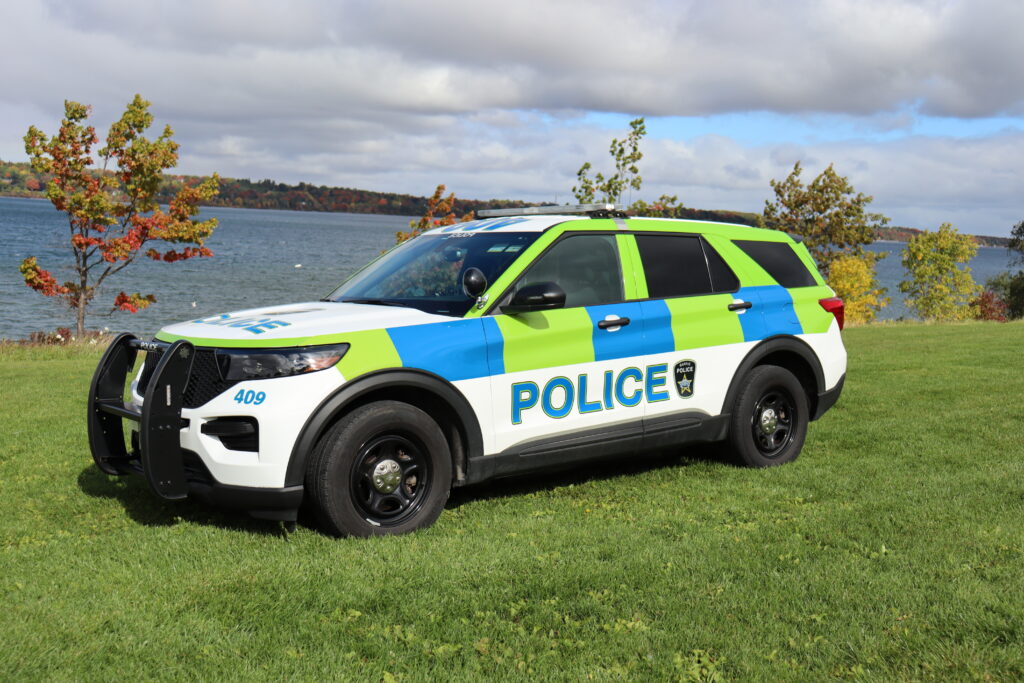
Features
Police vehicle designs: Public perceptions and policing implications
April 11, 2024 By Rylan Simpson
 Photo: Barrie Police Service
Photo: Barrie Police Service Police vehicles are symbols of pride for many police agencies. Police vehicles are also fundamental to the pursuit of modern policing. As the conduit by which most patrol is conducted, police vehicles provide essential transportation and storage for officers. Not all police vehicles, however, look the same. Some police vehicles are visibly marked via police decaling, whereas other police vehicles are not marked. Some police vehicles are a solid colour, whereas other police vehicles are multi-coloured. Police vehicle designs can impact key police performance measures, such as public detection, public recognition, and public perceptions of police. Empirically examining police vehicles and the perceptual effects of their designs is thus important.
Methodology
Working with my collaborators from the Barrie Police Service – Chief Rich Johnston, Madison Charman and Viktoria Tumilowicz – we assessed public perceptions of, and preferences toward, police vehicle designs. Using an online survey platform, we asked >3,000 Canadians to first indicate their preferences for various pictured police vehicle designs along seven different outcomes: aggressiveness, approachability, fairness, friendliness, predatoriness, trustworthiness and visibility. Next, we asked participants to freeform describe what they believed to be the most important components of a police vehicle design. Finally, we examined participants’ responses across these different question modalities to identify patterns and themes in the data.
Results
Participants’ close-ended responses revealed a preference for the now former dark blue design of the Barrie Police Service followed by a predominately white design and an all-yellow design. Participants’ open-ended responses revealed a strong preference for police vehicle designs that are highly visible and identifiable. Participants often explained the importance of these components with respect to vehicle equipment and presentation, including colour. Here, for example, participants pointed to the benefit of bright and reflective colours, including yellow. Participants also referenced the image of the police vehicle, emphasising the need for police vehicles to appear approachable and friendly – not militarised.
By maximising the identifiability and visibility of their police vehicles, especially those used for patrol purposes, police agencies may enhance public perceptions of police.
Advertisement
Discussion
Police vehicles are ubiquitous in modern policing. Most public observations of police occur while officers are occupying police vehicles. The results from our Canadian-based study add to the scholarly understanding of police vehicle designs and their relevance for policing outcomes. Our results also exhibit important implications for policing practice. At an abstract level, our results provide further evidence in support of the power of police vehicle designs for public perceptions. For example, participants overwhelmingly indicated their preference for the use of marked as opposed to non-marked police vehicles. At a more nuanced level, participants consistently argued that marked police vehicles should be highly identifiable and visible, including in all kinds of environments and conditions, and elicit positive messaging where possible.
Police agencies wishing to implement the principles of evidence-based policing should be mindful of the appearance of their police vehicles. By maximising the identifiability and visibility of their police vehicles, especially those used for patrol purposes, police agencies may enhance public perceptions of police. By adopting a vehicle design that adheres to these criteria, police agencies may also enhance the safety of occupying officers by reducing the risk of traffic collisions and enhance public compliance by reducing potential concerns about police impersonation. From this perspective, one could argue that the standardisation of a police vehicle design that adheres to these criteria would further bolster the utility of police vehicles.
Evidence to action: The case of the Barrie Police Service
In light of the findings from our study and related studies, the Barrie Police Service recently adopted a new Battenburg vehicle design to be implemented on their police vehicles moving forward. The Barrie Police Service crafted all elements of their new design, which includes lime-yellow and blue checkered blocks on a white vehicle base, with consideration of research. The agency’s hope in implementing this new design is to increase the identifiability and visibility of their officers as well as enhance public perceptions of police – all of which were identified as key priorities among study participants. To our knowledge, this is the first fleet roll-out of a Battenburg police vehicle design in North America.
Related Reading
- Simpson, R., Tumilowicz, V., Charman, M., & Johnston, R. (2023). Public perceptions of, and preferences toward, police vehicle designs: A mixed-method test of a theoretical question. Journal of Criminal Justice, 89, 102119. https://doi.org/10.1016/j.jcrimjus.2023.102119.
- Simpson, R. (2019). Police vehicles as symbols of legitimacy. Journal of Experimental Criminology, 15(1), 87-101. https://doi.org/10.1007/s11292-018-9343-5.
Rylan Simpson, Ph.D. is an assistant professor in the School of Criminology at Simon Fraser University. He is an expert in police perception research and has studied the effects of police vehicle aesthetics on public perceptions of police. He has received numerous awards for his policing scholarship and engagement with policing officials. He has recently published his work in Criminology & Public Policy, PLoS ONE, Journal of Experimental Criminology, Journal of Criminal Justice, Crime Science, and Crime & Delinquency.
Print this page